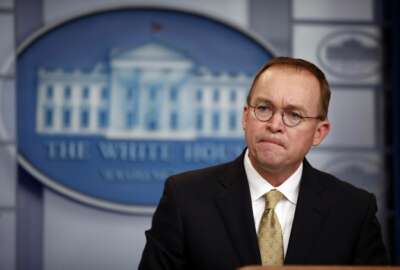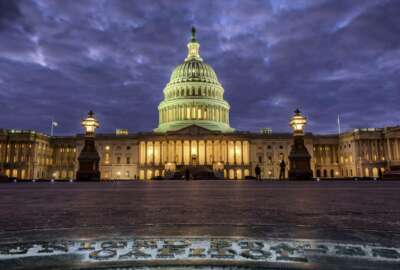
Trump budget proposes staff cuts within IRS, NIST, EPA; gives windfall to Census
President Donald Trump's budget proposal for fiscal 2019 calls for increased funding to the IRS' enforcement services, but reduces the agency's overall budget by...
Subscribe to Federal Drive’s daily audio interviews on iTunes or PodcastOne.
President Donald Trump’s budget proposal for fiscal 2019 calls for increased funding to the IRS’ enforcement services, but reduces the agency’s overall budget by millions of dollars.
The president’s FY 2019 budget plan also calls for cutting more than 4,000 jobs from the IRS’ taxpayer services division, just a month after the agency’s internal watchdog, National Taxpayer Advocate Nina Olson, reported to Congress that with current staffing levels, the IRS would only be able to answer 40 percent of calls to its tax-help hotline during the 2018 filing season.
The White House budget document funds the IRS at $11.1 billion for FY 2019, down from $11.2 billion enacted in FY 2017. The top-line budget for the next fiscal year also includes $2.3 billion for running tax filing and compliance IT systems and $110 million for an IT modernization fund.
The IRS currently employs 28,692 workers in its taxpayer services division. The White House proposes cutting that workforce to 24,668 employees by the end of fiscal 2019.
“The Budget includes funding for Taxpayer Services that will allow the IRS to continue delivering services to taxpayers using a variety of in-person, telephone and web-based methods. These tools help taxpayers understand their obligations, correctly file their returns, and pay taxes due in a timely manner. The IRS is committed to increasing the service options available through the IRS website and mobile application, allowing more taxpayers to reach the IRS through the Internet,” the White House FY 19 budget document states.
The move away from staffing tax-help call centers in favor of more robust online customer service tools is further supported by the priorities outlined in a supplemental government modernization document, in which the Trump administration calls for “shifting from low-value to high-value work.”
The White House proposal calls for a $15 billion increase in enforcement spending over the next 10 years, delivering in part on a promise made by Treasury Secretary Steve Mnuchin that the Trump administration would seek more money for the rollout of the tax reform legislation the president signed into law last December.
“These additional investments proposed over the next 10 years are estimated to generate approximately $44 billion in additional revenue at a cost of $15 billion, yielding a net savings of $29 billion over 10 years,” the FY 2019 budget proposal states.
The National Treasury Employees Union told Federal News Radio in a statement that it urges Congress to fund taxpayer service beyond what the White House has proposed.
“Under this regressive budget proposal, the IRS would have fewer employees to collect the money needed to run the country, answer questions from taxpayers, and prevent tax evasion. Even while calling for 4,000 fewer employees in taxpayer services, the administration acknowledges that the personnel cuts would lower the level of telephone customer service from 75 percent in 2018 to 47 percent in 2019, delay the sorting and shipping of incoming mail, delay responses to requests from taxpayers and sideline seasonal workers,” NTEU President Tony Reardon said in a statement.
NIST
The National Institutes of Standards and Technology, which develops compliance standards on everything from cybersecurity to digital authentication to information sharing for both industry and government, faces a massive cut in fund and personnel under the White House budget proposal.
Under the FY19 spending plan, the Trump administration would defund NIST by more than a third of what it received in fiscal 2017 and 2018.
The White House spending plan gives NIST a $629 million budget, more than a $316 million reduction from its current levels.
In addition, the budget document would also cut NIST’s workforce by nearly 400 employees — more than a 15 percent reduction.
“Through the NIST Laboratories, the bureau will maintain its core capabilities in measurement science, continuing to provide the measurements and standards that accelerate innovation,” the Commerce Department said in its justification of the Trump administration’s budget proposal.
Census
As the Census Bureau enters the home stretch for its 2020 count, the Trump administration plans to more than double the agency’s budget.
The White House budget provides $3.8 billion to the Census Bureau, an increase of more than $2.3 billion, that reflects the nature of the 2020 count entering the home stretch.
“The funding request for FY 2019 reflects the massive scope of work that must be completed prior to the start of FY 2020. At the start of FY 2019, the scope and design of the 2020 Census can no longer be altered. If the Census Bureau does not receive the funding requested for the entirety of this work, the quality of the 2020 Census will suffer,” the Commerce Department said in its justification of the White House budget.
At the heart of the 2020 count is the Census Enterprise Data Collection and Processing program (CEDCaP), an integrated set of systems the agency has been developing to make it easier to share information across the organization.
But with CEDCaP running behind schedule and over budget, the Government Accountability Office has listed the 2020 count on its list of high-risk programs.
“Executing a decennial census requires the proper integration of multiple IT systems with operational plans, methods and procedures to be successful. If any of these elements fail or do not integrate properly, operations may be disrupted, costs could rise, data could be lost, or data quality could be compromised,” the Commerce Department wrote.
The Commerce Department says the White House’s FY 2019 request gives the Census Bureau the right resources to manage risk.
EPA
Despite reports in January that the Environmental Protection Agency has fewer than 15,000 employees for the first time in decades, the Trump administration plans to make further workforce cuts.
The FY 2019 budget proposal would cut more than 2,400 employees from the Environmental Programs and Management (EPM) staff, more than a quarter of the 9,729 it currently has.
Of the $6.1 billion proposed for the EPA in FY 2019, more than 27 percent of funding would go to EPM.
“EPA will ensure its workforce is positioned to accomplish the Agency’s mission effectively by providing access to quality training and development opportunities that will improve staff’s and managers’ skills, knowledge and performance, and prepare them to capitalize on opportunities that advance progress. EPA will improve its workforce planning and management, strengthen its Senior Executive Service, and focus on developing and maintaining a highly-skilled technical workforce,” the agency said in its justification of the president’s budget.
Copyright © 2025 Federal News Network. All rights reserved. This website is not intended for users located within the European Economic Area.
Jory Heckman is a reporter at Federal News Network covering U.S. Postal Service, IRS, big data and technology issues.
Follow @jheckmanWFED





